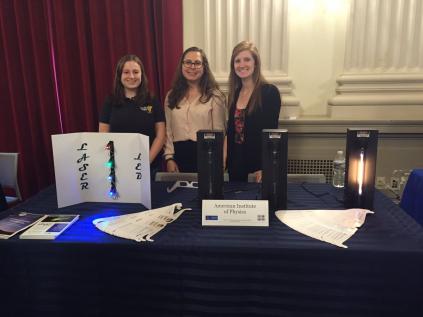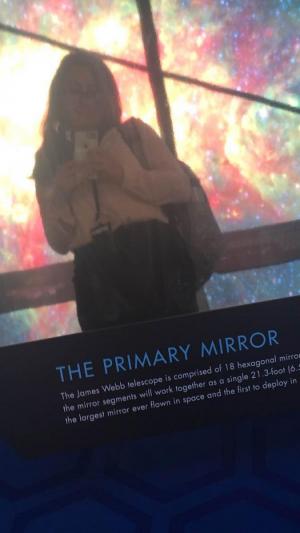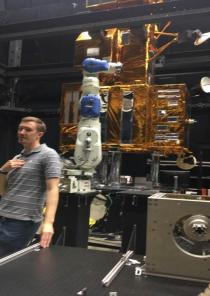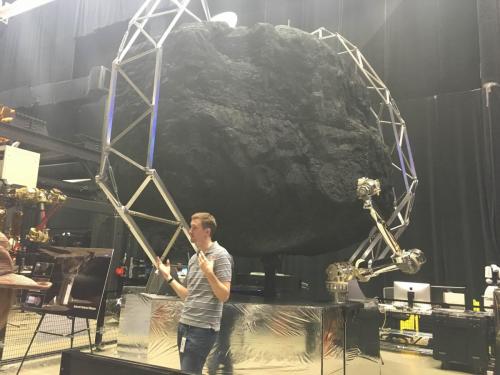Thursday, July 14, 2016
By:
This past week has brought a lot of realizations and progress in my work, as well as more opportunities to learn about NASA and meet other people in STEM.
My mentor was gone at a conference, so I was left alone with my code. Now, I’m attempting to model the absorptance of a specific type of epoxy mixed with scattering microbeads. This requires a lot of knowledge about dielectric materials and reflectance coefficients. The overall goal is to create a material that can absorb all incident light at the infrared wavelength, while leaving other wavelengths alone so that they can be detected by the instruments. When measuring the cosmic microwave background from space, it’s important to use instruments that function at their peak capacity at temperatures around 2.7 K. However, there is infrared radiation in space that could heat up the instruments or just flood the detectors with radiation that is much brighter than the microwaves that are of interest. That is where a tuned absorptive material comes in handy, shielding the electronics and making sure the correct data is being collected.
While preparing this model, I made sure that I had some break time to go tour the Goddard campus. It’s amazing how much scientific progress is being made just a few buildings away from me, and how many missions NASA is preparing for in just a few years.
Our tour began with visiting the clean room that houses the James Webb Space Telescope, a work in progress that is projected to be launched into space in 2018. As a successor to the Hubble Space Telescope, JWST is going to be looking into deep space with an infrared-optimized telescope to try to gain a better understanding of our place in the universe. It’s being put together in a sealed clean room to ensure the accuracy of the instruments and to protect it from any particulates that could cause issues with any of its functions in space. Even one fingerprint on a single mirror plate could skew data immensely, so each scientist and engineer that goes to work on the telescope has to endure a thorough cleaning process and cover up from head to toe. When I visited, the JWST was hiding behind the scaffolding being used for its construction, so I couldn’t snap very many pictures. But this is what it’s going to look like when it’s finished.

The next tour I went on last week was to view the Robotics Operations Center. When I signed up, I had no clue what sort of things they were going to show us, but I am so happy I went. As we entered the robotics center, the first thing to look at was the huge model of a satellite sitting next to a robotic arm. The engineer started telling us about the arm, and how it was actually from an assembly line, but NASA was attempting to reprogram it and retrofit it to be able to access the fuel tanks of a satellite and refuel it so that it can stay in orbit and produce more data. Their mission required a lot of new ideas, since the satellites that are currently in orbit were not built with refueling in mind. The arm would need to be able to cut through insulation and wires holding the cap down, and then be able to unscrew it, fill the tank with highly combustible hydrazine, and close the cap without losing any fuel. The goal of the project is to refuel one satellite so that NASA can show the world that it can be done. From there, it will be left to the private sector to compete and recreate the technology.
The second model in the lab looked a little odd, a huge rock being held in between some huge metal arms. The engineer explained that NASA was attempting to create a way to avoid catastrophic asteroid collisions. This process means that we would be launching a robotic system that would be able to get to an asteroid, orbit it, identify where on the surface there may be a huge boulder, and then remove said boulder with the mechanical arms. This slight change in mass would mean a new trajectory for the asteroid, and that could mean the difference between a collision and a slight miss. Technology like this could also mean advances in asteroid mining efforts, but for now NASA is using their engineering for good.
Other than the tours, SPS got to attend and show demos at the Women’s Policy Inc. STEM Fair on Capitol Hill. This was my first real networking event outside of NASA, and I was very excited to talk to other professional women in STEM. Recently I’ve been thinking about how I want to have a mentor-type role for other girls in STEM when I get back to my college, and the women at this fair gave me so many ideas. I heard from the Girl Scouts of America about how to plan badge workshops, and from the American Association of University Women on how to plan summer STEM camps for girls (just like the ones I went to as a kid!), and overall I left this event feeling like I taught a lot of people about physics and they taught me about how I can use it to give back. I have always believed that it’s important to provide women-specific opportunities in STEM, because it’s how we fight back against the ingrained sexism in the field. When I attended girl-specific events as a kid, it gave me confidence and ideas and opened up opportunities. I needed that support group of girls in order to believe that I was smart and capable, and that science wasn’t something over my head. In fact, I never felt discriminated against as a girl in science until I reached college. That’s when the doubt began to creep in, as I lost a lot of the supportive framework that kept me motivated all through high school. But as I’m going into my junior year, I’ve realized that the best way to get this framework back is to provide it for other young girls who need it. The contacts I made at this fair will hopefully make this a reality.

As the deadlines become all too real and the fall semester looms closer, I hope to continue working as hard as I can so that I can go home with experience, motivation, new networks, and so many new friends that will continue to be influential long past this internship.
Dahlia Baker



